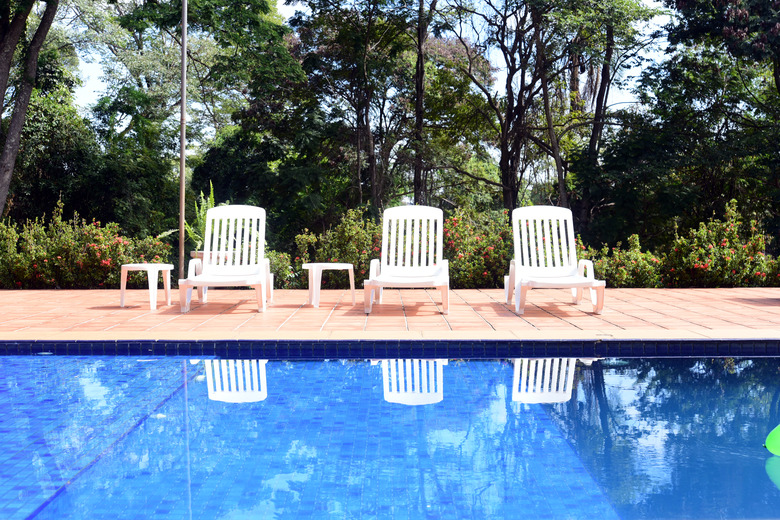How To Raise Chlorine Or Bromine In A Pool
We may receive a commission on purchases made from links.
Chlorine and bromine have been the standard as sanitizers since the early 1900s. Anyone who has swum in a public pool knows the very distinct smell of chlorine, but bromine is a little different. Knowing and maintaining various attributes of your pool water are the first steps in raising chlorine or bromine levels. One key attribute that is easily overlooked is how much water your pool holds. This will determine how much of either chemical is required for the levels you are trying to establish.
The Importance of Water Attributes
The Importance of Water Attributes
Maintaining pool water attributes involves the measurement of acidity (pH), alkalinity, and calcium hardness. Whether you are using chlorine or bromine, these attributes affect how well the sanitizer will work while maintaining an algae-free, clear pool. A quality pool water test kit will measure these attributes fairly simply. Follow the instructions for your test kit to check these levels before attempting to raise chlorine or bromine in a pool.
pH and Alkalinity Levels
pH and Alkalinity Levels
Whether using chlorine or bromine for disinfecting pool water, you want to maintain the right pH and alkalinity levels. The pH level is typically measured by checking the acidity of the pool water. The lower the pH level, the more acidic the water; the higher the pH, the more basic the water.
The pH scale is a 14-point scale: 7 is neutral; anything below 7 is acidic; anything above 7 is basic. The ideal pH for pool water is 7.5, or in the range of 7.4 to 7.6.
Alkalinity and pH typically go hand in hand and work together. When you add chemicals to your pool to raise or lower the pH, the alkalinity will rise or fall, respectively, and vice versa. The numbers to shoot for while establishing the pH and alkalinity in pool water are 7.4 to 7.6 pH and 100 to 150 parts per million of alkalinity.
Calcium Hardness Level
Calcium Hardness Level
Another attribute of pool water chemistry is calcium hardness. This attribute is not as important in the pool water as pH and alkalinity for sanitizing a pool, but it still has its place in good pool water chemistry. Usually, you just need to add the right calcium increaser or decreaser once a year, and it will be maintained without too much trouble. Some pool shocks have calcium in their chemical makeup. This can add issues while trying to maintain 175 to 225 parts per million of calcium hardness.
Warning
Chlorine can cause serious chemical burns, so be sure to take proper safety precautions before using any chemicals. Wear rubber gloves and eye protection with splash shields as well as old closed-toe shoes.
How to Raise the Chlorine Level in a Pool
How to Raise the Chlorine Level in a Pool
Once the pool water chemistry is properly adjusted, it is time to sanitize the pool by raising the chlorine in the pool. Chlorine shock treatments come in a couple of different forms: liquid and granular. Chlorine shock treatment is the easiest way to raise the chlorine levels in a pool. Follow the instructions for the shock treatment you intend to use as well as the dosage required for the quantity of water in your pool.
Once the chlorine level is raised between 1 and 4 parts per million, it will need to be maintained. This can be done by simply adding a floating chlorine dispenser. Another more advanced way of maintaining the chlorine level is adding a chlorine feeder to your pool system. Adding a stabilizer to pool water will help the chlorine levels maintain a clean and clear pool.
Raising the Bromine Level in a Pool
Raising the Bromine Level in a Pool
Bromine is a close cousin to chlorine. A benefit of a good shock treatment is that it will regenerate the bromine levels. Chlorine does not share these same attributes. Bromine is very susceptible to sunlight, so maintaining a proper bromine level in an outdoor pool may prove more difficult than chlorine. Maintaining a bromine level of 3 to 5 parts per million is very similar to chlorine in that a floating dispenser or automatic bromine feeder can be used.
Adding shock after heavy use or rain along with making it a weekly task will produce a clean, clear, and inviting pool for the entire season.
Warning
After shocking the pools, always wait at least eight hours before you go swimming. Leave the pool uncovered after you shock it or else dangerous fumes released by the shock chemicals will get trapped under the pool cover.
